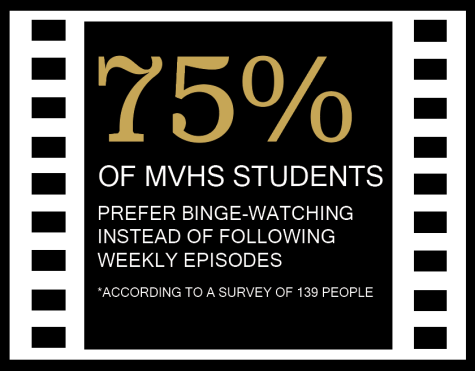Next episode starts in 10…
Examining how the evolution of TV release formats has divided viewers
February 10, 2023
As streaming services such as Netflix and Hulu have shot to the forefront of mainstream media throughout the past decade, so has binge-watching or “binging.” While many streaming platforms have adapted by releasing entire seasons at once, not everyone has accepted this change as positive.
English teacher Derek Lu grew up as part of the millennial generation before online streaming platforms took over television media. Lu’s preference for weekly-released television has not changed, as he says that shows which release entire seasons at once tend to focus on immediate entertainment for “bingeability” rather than including engaging elements that entice viewers to return.
“With the term binging, I picture a couch potato — someone spending all afternoon on the couch consuming hours of television back to back,” Lu said. “It’s entertaining, which is why we do it, but it doesn’t lead to active viewing and active interpretations of the story. The shows that are better served by that weekly consumption model are those that have a season-long arc, where you can really watch the characters grow, and their storylines become flushed out.”
According to Lu, the weekly format has allowed him to revisit his favorite characters over the course of multiple decades, most notably Meredith Grey from Grey’s Anatomy, whom he refers to as a “familiar friend [I] can revisit week after week.” The time between periodical episode releases also allows for discourse and deeper discussion about the content of the show — a sentiment that senior Sneha Agarwal shares. However, Agarwal doesn’t see this as something everyone has to appreciate.
“Some people like discussing a lot of the shows they watch online or on discussion posts, but I don’t think that I do that too often,” Agarwal said. “If I’m watching a show, I just talk about it with my friends. I don’t really enjoy the suspense as much as maybe some other people do … [I] get the most joy and feel more connected to it when [I] have it all at once.”
Despite this, Agarwal admits that her interest in shows she binges on is often short-lived, rarely lasting more than a week after finishing a series. She sees television and media as extremely addictive and is frequently affected by “post-show depression” — the sadness that comes after finishing a series one has become and emotionally attached to.
Freshman Sarah Shelke also admits to occasionally experiencing post-show depression after binge-watching but adds that binging is the only way she feels satisfied and emotionally engaged with a show.
“[Binge-watching lets you] build a certain relationship and bond with the characters and the setting, and that’s when you … just want to keep rewatching it,” Shelke said. “I also think that [weekly releases do] keep you somewhat distant, versus just binge-watching the show all at once and seeing how a character or story develops.”
Ultimately, Lu attributes the divided preferences to the generational gap among viewers. While current generations have adjusted to how the internet has shaped entertainment, Lu recalls growing up during a time when the technology providing accessibility was only just beginning to become mainstream.
“I think [Gen Z is] so used to immediacy and accessibility,” Lu said. “Everything is literally at your fingertips. All your friends, all your shows, all your contacts, everything is accessible from your phone and social media; it is easier to just be able to queue up an entire season of ‘Squid Game’ or ‘Ginny & Georgia.’ When I was growing up, I didn’t have any of that.”


















